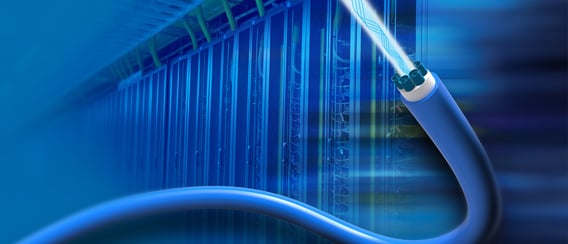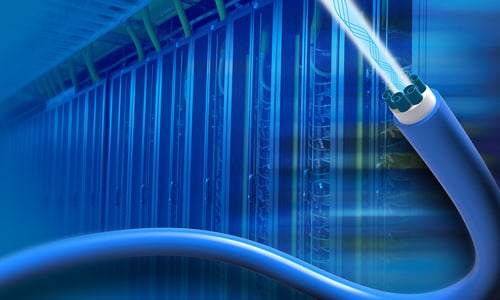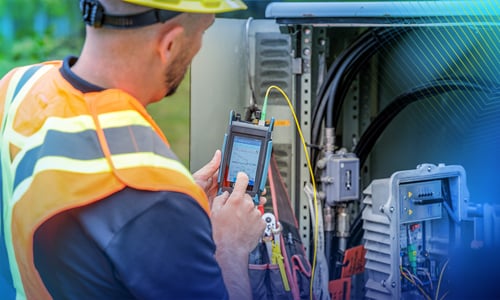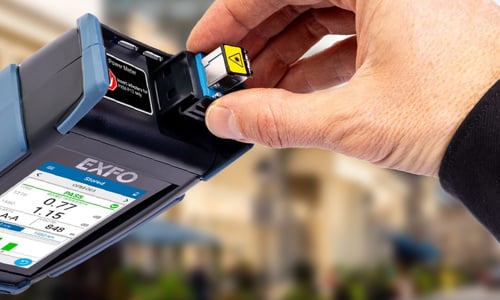Hollow-core fiber: power and precision for critical networks
As fiber-optic networks must continuously adapt to the exponential growth of data while maintaining low latency, a new technology is emerging on the market and rapidly gaining traction. This technology, known as hollow-core fiber, promises to transform network performance, particularly in critical environments such as data centers and financial infrastructures.
What is hollow-core fiber?
Unlike conventional fiber, which has a solid glass core, this new generation of fiber features a central channel filled with gas or air. Light propagates through this medium, which has a much lower refractive index than glass. Specialized cladding structures, often made of glass with periodic patterns, guide the optical signal through the channel and prevent it from escaping. This fundamental change accelerates the propagation of light—no longer slowed by glass—and enables an unprecedented reduction in latency.
Speed and stability for demanding environments
Hollow-core fiber technology addresses a pressing need: delivering speed without compromising stability. In a world where data centers, cloud environments, and real-time services demand ever-higher performance, latency has become a critical issue. Hollow-core fiber emerges as a key player thanks to its many advantages:
- Increased speed: Light travels at about 200,000 km/s through glass. In hollow-core fiber, where light travels in a vacuum, speeds approach 300,000 km/s. That’s a 40% increase—an essential advantage in environments where every microsecond counts.
- Reduced signal loss: Recent advances drop signal losses to as low as 0.05 dB/km, outperforming traditional single-mode fiber and allowing for longer-distance transmissions.
- Tolerance to nonlinear effects: With its wider, non-solid core, hollow-core fiber is less sensitive to optical distortions, resulting in higher signal quality.
Turning performance into strategic advantage
These benefits translate into a significant strategic lever, opening the door to key applications in next-generation networks, including high-frequency trading, cloud computing, and 5G networks. Some of these applications include:
1. Data center interconnection (DCI)
Cloud giants are among the first to adopt hollow-core fiber to enhance interconnections between their data centers. This technology allows them to:
- Reduce latency between sites over 80 km apart—crucial for real-time data sync and AI/ML model training—enabling distant sites to operate as one and overcome energy limits on data center builds.
- Increase strategic flexibility by selecting infrastructure locations based on economic criteria like energy or real estate costs, while maintaining optimal performance between sites.
2. Finance and nano-trading
In financial markets, speed equals profit. Being able to buy or sell microseconds ahead of competitors can represent millions. Hollow-core fiber becomes a strategic asset by reducing latency between trading venues and giving high-frequency traders a decisive competitive edge.
3. Artificial intelligence (AI)
AI workloads—driven by machine learning algorithms and neural networks—require the rapid processing of massive datasets and real-time decision-making. These applications, from autonomous vehicles to smart devices, cannot afford network lag or interruptions. Hollow-core fiber was developed to meet these heavy demands, offering superior network quality, improved latency, and secure data transmission. By transporting more data with lower latency, HCF enables quick reactions and split-second decisions, allowing AI models to process information faster and perform more accurately in mission-critical environments.
Progress and challenges: the realities of hollow-core fiber
Although promising, this technology comes with challenges:
- Mechanical sensitivity: Cabling remains more delicate than with conventional fiber.
- Compatibility with existing networks: Hybrid deployments (traditional + hollow-core) will need to coexist, requiring precise measurements and reliable diagnostics.
- Standardization and certification: The current lack of established standards complicates large-scale integration. As with data center certification, rigor is essential to ensure consistent performance.
Progress, however, is rapid. Each development cycle introduces advancements that make hollow-core fiber increasingly deployable and less experimental.
EXFO hollow-core fiber test solutions
Traditional approaches often fall short when applied to this disruptive technology, which demands new methods for measuring loss, return loss, and overall transmission quality. EXFO, a leader in innovative fiber testing, is at the forefront of this transition, equipping data centers, service providers and innovators with a comprehensive portfolio of HCF-optimized solutions
Among these solutions, OTDRs stand out as EXFO’s core expertise and leading product family. Unlike other instruments that are inherently compatible with HCF, the OTDR required specific developments to ensure reliable results.
For field deployment, EXFO's Hollow-Core Fiber OTDR analysis software, part of a Hollow-Core Fiber OTDR Test Kit, provides accurate fault location and loss measurements where traditional OTDRs fall short. Its high dynamic range makes the hardware inherently well suited for HCF characterization. Going further, the dedicated uni- and bi-directional analysis software extracts key fiber parameters such as loss, ORL and length. The adapted analysis also enables splice loss and reflectivity measurements—capabilities that require specific innovation for HCF, making it a unique and essential tool for this new fiber technology.
Other hollow-core fiber capable products for testing in the field include the FTBx-570 single-ended CD/PMD analyzer, which ensures reliable characterization of dispersion parameters that directly impact high-speed performance. The MaxTester 945 optical loss test set (OLTS), with an optional feature, streamlines validation of fiber length, insertion loss and return loss, while the FIP-500 fiber inspection scope safeguards network integrity with fast, automated end-face analysis. The FTBx-88810 Series 1G-800G test solution, equipped with the EtherBERT test application, enables precise latency measurements essential for validating the ultra-low delay performance of hollow core fiber, supporting next-generation high-speed, time-sensitive networks.
At the lab and R&D level, the CTP10 test system delivers ultra-high resolution spectral loss measurements—down to 0.02 pm across the 1240 nm to 1680 nm range—enabling precise analysis of effects such as CO₂ absorption over long distances of more than 100 km.
Preparing the networks of tomorrow
Hollow-core fiber is not just a technical innovation—it represents a strategic evolution that could redefine how networks meet the growing demands of the digital world. It is clear that deployment, testing, and monitoring teams must become familiar with this technology and anticipate its integration into their future practices.
By combining lab-grade precision with field-ready practicality, decades of fiber testing expertise, and a strong commitment to innovation, EXFO provides the industry with a clear path to scale hollow-core fiber from research environments into live networks—paving the way for faster, more efficient and more reliable connectivity.




